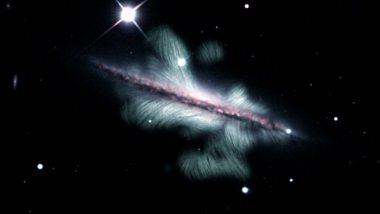New Mexico, July 22: The galaxy NGC 4217 is a star-forming, spiral galaxy, similar to our own Milky Way, 67 million light-years from Earth in the constellation Ursa Major.
The galaxy is seen edge-on in a visible-light image from the Sloan Digital Sky Survey and Kitt Peak National Observatory, and the magnetic field lines, shown as green, are revealed by the National Science Foundation's Karl G. Jansky Very Large Array (VLA) radio telescope.
The magnetic field lines extend as much as 22,500 light-years beyond the galaxy's disk. Scientists know that magnetic fields play an important role in many processes, such as star formation, within galaxies. However, it is not fully understood how such huge magnetic fields are generated and maintained.
NRAO Tweet:
67 million light-years from Earth, this star-forming, spiral galaxy, NGC 4217, is seen edge-on in a visible-light image from @sdssurveys and @KittPeakNatObs. Magnetic field lines in green are revealed Jansky Very Large Array (#VLA) radio telescope pic.twitter.com/B16e03a2fZ
— NRAO (@TheNRAO) July 21, 2020
A leading explanation, called the dynamo theory, suggests that magnetic fields are generated by the motion of plasma within the galaxy's disk. Ideas about the cause of the kinds of large vertical extensions seen in this image are more speculative, and astronomers hope that further observations and more analysis will answer some of the outstanding questions.
"This image clearly shows that when we think of galaxies like the Milky Way, we should not forget that they have galaxy-wide magnetic fields," said Yelena Stein, of the Centre de Donnees astronomiques de Strasbourg, leader of the study.













 Quickly
Quickly





















